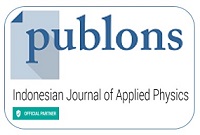Sea Wave Height Monitoring Prototype as an Early Warning System for Tidal Flood Disaster
Abstract
Keywords
Full Text:
PDFReferences
1 BNPB. (2023). Risiko Bencana Indonesia: Memahami Risiko Sistemik di Indonesia. Jakarta: Pusat Data, Informasi, dan Komunikasi Kebencanaan BNPB.
2 Pinet, P. R. (2021). Invitation to Oceanography. Burlington: Jones & Bartlett Learning.
3 Craghan, M. (2003). Physical Geography A Self-Teaching Guide. Canada: John Wiley & Sons Inc.
4 Syafitri, A. W., & Rochani, A. (2021). Analisis Penyebab Banjir Rob di Kawasan Pesisir Studi Kasus: Jakarta Utara, Semarang Timur, Kabupaten Brebes, Pekalongan. Jurnal Kajian Ruang, 1(1), 16–28. https://dx.doi.org/10.30659/jkr.v1i1.19975
5 Muryani, C., Nugraha, S., & Prihadi, S. (2017). Impact of Coastal Erosion and Tidal Flood to Land Loss at Sriwulan Village, Sayung, Demak, Central Java Province. 1st International Conference on Geography and Education (ICGE 2016), 53–56. Malang: Atlantis Press.
6 Höffken, J., Vafeidis, A. T., MacPherson, L. R., & Dangendorf, S. (2020). Effects of the Temporal Variability of Storm Surges on Coastal Flooding. Frontiers in Marine Science, 7, 1–14. https://doi.org/10.3389/fmars.2020.00098
7 Tiatama, S. H., Atmodjo, W., & Widiaratih, R. (2024). Analisis Keterkaitan Fenomena Supermoon Terhadap Komponen Pasang Surut Di Perairan Semarang, Jawa Tengah. Indonesian Journal of Oceanography, 6(2), 114–120. https://doi.org/10.14710/ijoce.v6i2.19036
8 Fajrin, A. R. M., Hayati, A., & Faqih, M. (2020). The Spatial Characteristics of Tidal Flood Vulnerability and Adaptation Strategy in Tambak Lorok Kampung Settlement. The 6th International Seminar on Science and Technology, 363–371. Surabaya: Institut Sepuluh Nopember. http://dx.doi.org/10.12962%2Fj23546026.y2020i6.11124
9 Musarofa, Siswanti, Y. D., & A-Rosyid, L. M. (2024). Analisis Pengaruh Banjir Rob Terhadap Kualitas Air Tanah di Kawasan Pesisir Selatan Puger Kabupaten Jember. Journal of Mechanical Engineering, 1(1), 52–59. https://doi.org/10.47134/jme.v1i1.2190
10 Triana, Y. T., & Hidayah, Z. (2020). Kajian Potensi Daerah Rawan Banjir Rob dan Adaptasi Masyarakat di Wilayah Pesisir Utara Surabaya. Juvenil:Jurnal Ilmiah Kelautan Dan Perikanan, 1(1), 141–150. https://doi.org/10.21107/juvenil.v1i1.6961
11 Pratama, M. B. (2019). Tidal Flood in Pekalongan: Utilizing and Operating Open Resources for Modeling. IOP Conference Series: Materials Science and Engineering, 676(1), 1–11. IOP Publishing Ltd. https://doi.org/10.1088/1757-899X/676/1/012029
12 Afifah, A. S., Sari, M. M., Suhardono, S., & Suryawan, I. W. K. (2023). Inisiatif Penanaman Mangrove sebagai Upaya Mitigasi Banjir Rob di Kabupaten Kendal : Studi Literatur. Jurnal Serambi Engineering, 8(4), 7249–7255. https://doi.org/10.59431/ajad.v3i3.221
13 Prawira, M. P., & Pamungkas, A. (2014). Mitigasi Kawasan Rawan Banjir Rob di Kawasan Pantai Utara Surabaya. Jurnal Teknik Pomits, 3(2), 160–165.
14 Pasi, A. A., & Bhave, U. (2015). Flood Detection System Using Wireless Sensor Network. International Journal of Advanced Research in Computer Science and Software Engineering, 5(2), 386–389.
15 Undang-Undang Republik Indonesia Nomor 24 Tahun 2007 tentang Penanggulangan Bencana. Lembaran Negara Republik Indonesia Tahun 2007 Nomor 66 Tambahan Lembaran Negara Republik Indonesia Nomor 4723.
16 Sakya, A. E. (2018). Reviewing Global Development of Multi-Hazard Early Warning System With The Perspective of Its Development in Indonesia. MATEC Web of Conferences, 229, 1–7. EDP Sciences. https://doi.org/10.1051/matecconf/201822902020
17 Estu, D. S., Yantidewi, M., Rusdi, B. M., Adikuasa, M. B., & Khoiro, M. (2023). Alat Monitoring Ketinggian Air Laut Berbasis IoT dengan Nodemcu ESP32 dan HC-SR04. Jurnal Kolaboratif Sains, 6(7), 585–597. https://doi.org/10.56338/jks.v6i7.3782
18 Hassan, W. H. W., Jidin, A. Z., Aziz, S. A. C., & Rahim, N. (2019). Flood Disaster Indicator of Water Level Monitoring System. International Journal of Electrical and Computer Engineering, 9(3), 1694–1699. https://doi.org/10.11591/ijece.v9i3.pp1694-1699
19 Suharyo, O. S. (2018). Rancang Bangun Alat Pengukur Gelombang Permukaan Laut Presisi Tinggi (A Prototype Design). Applied Technology and Computing Science Journal, 1(1), 18–29. https://doi.org/10.33086/atcsj.v1i1.6
20 Damayanti, M. A., Wahyuningtyas, S. H., Balistyadhana, D. Z., Hapsari, A. D., Shammah, A. El, Yusa, N. C. A., … Isworo, S. (2024). The IoT-Based Early Warning System for Detecting High Tide Floods (ROB-EWS) in Tambak Lorok, Semarang Indonesia. Journal of Geography, Environment and Earth Science International, 28(10), 13–24. https://doi.org/10.9734/jgeesi/2024/v28i10822
21 Panda, K. G., Agrawal, D., Nshimiyimana, A., & Hossain, A. (2016). Effects of Environment on Accuracy of Ultrasonic Sensor Operates in Millimetre Range. Perspectives in Science, 8, 574–576. https://doi.org/10.1016/j.pisc.2016.06.024
22 Jones, L. D., & Chin, A. F. (1991). Electronics Instruments and Measurements. New Jersey: Practice-Hall.
23 Susanti, A. F. S., Putranto, R. T., Rahmadani, M. A., Mustaqim, I., Saliyo, A. D. S., Sazidah, H., … Trianto, A. (2024). Instrumentation for Monitoring and Early Warning of Tidal Flood Using ESP32S2 Microcontroller and A01NYUB Ultrasonic Sensor in Tambakrejo, Semarang. IOP Conference Series: Earth and Environmental Science, 1350(1). Institute of Physics. https://doi.org/10.1088/1755-1315/1350/1/012046
24 Budimir, M., Donovan, A., Brown, S., Shakya, P., Gautam, D., Uprety, M., … Dugar, S. (2020). Communicating Complex Forecasts: An Analysis of The Approach in Nepal’s Flood Early Warning System. Geoscience Communication, 3(1), 49–70. https://doi.org/10.5194/gc-3-49-2020
Refbacks
- There are currently no refbacks.
















